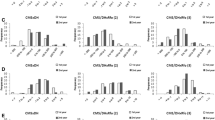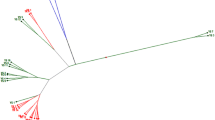Abstract
Genetic distances (GDs) based on morphological characters, isozymes and storage proteins, and random amplified polymorphic DNAs (RAPD) were used to predict the performance and heterosis of crosses in oilseed rape (Brassica napus L.). Six male-sterile lines carrying the widely used Shaan2A cytoplasm were crossed with five restorer lines to produce 30 F1 hybrids. These 30 hybrids and their parents were evaluated for seven agronomically important traits and their mid-parent heterosis (MPH) at Yangling, Shaanxi province in Northwest China for 2 years. Genetic similarity among the parents based on 34 isozyme and seven protein markers was higher than that based on 136 RAPDs and/or 48 morphological markers. No significant correlation was detected among these three sets of data. Associations between the different estimates of GDs and F1 performance for some agronomic traits were significant, but not for seed yield. In order to enhance the predicting efficiency, we selected 114 significant markers and 43 favoring markers following statistical comparison of the mean values of the yield components between the heterozygous group (where the marker is present only in one parent of each hybrid) and the homozygous group (where the marker is either present or absent in both parents of each hybrid) of the 30 hybrids. Parental GD based on total polymorphic markers (GDtotal, indicating general heterozygosity), significant markers (GDsign, indicating specific heterozygosity) and favoring markers (GDfavor, indicating favoring-marker heterozygosity) were calculated. The correlation between GDfavor or GDsign and hybrid performance was higher than the correlation between GDtotal and hybrid performance. GDsign and GDfavor significantly correlated with plant height, seeds per silique and seed yield, but not with the MPH of the other six agronomic traits with the exception of plant height. The information obtained in this study on the genetic diversity of the parental lines does not appear to be reliable for predicting F1 yield and heterosis.



Similar content being viewed by others
References
Ali M, Copeland LO, Elias SG (1995) Relationship between genetic distance and heterosis for yield and morphological traits in winter canola (Brassica napus L.). Theor Appl Genet 91:118–121
Betran FJ, Ribaut JM, Beck D, de Leon DG (2003) Genetic diversity, specific combining ability, and heterosis in tropical maize under stress and nonstress environments. Crop Sci 43:797–806
Cerna FJ, Cianzio SR, Rafalski A, Tingey S, Dyer D (1997) Relationship between seed yield heterosis and molecular marker heterozygosity in soybean. Theor Appl Genet 95:460–467
Cheres MT, Miller JF, Crane JM, Knapp SJ (2000) Genetic distance as a predictor of heterosis and hybrid performance within and between heterotic groups in sunflower. Theor Appl Genet 100:889–894
Corbellini M, Perenzin M, Accerbi M, Vaccino P, Borghi B (2002) Genetic diversity in bread wheat, as revealed by coefficient of parentage and molecular markers, and its relationship to hybrid performance. Euphytica 123:273–285
Dier BW, McVetty PB, Osborn TC (1996) Relationship between heterosis and genetic distance based on restriction fragment length polymorphism marker in oilseed (Brassica napus L.). Crop Sci 36:79–83
Duley JW, Saghai MA (1991) Molecular marker and grouping of parents in maize breeding programs. Crop Sci 31:718–723
Frei OM, Stuber CW, Goodman MM (1986) Use of allozymes as genetic markers for predicting performance in maize single cross hybrids. Crop Sci 26:37–42
Gan L, Wang X (1999) Genetic diversity analysis of rapeseed for the storage protein. J Huazhong Agric Univ 18:528–532
Goldshalk EB, Lee M, Lamkey KR (1990) Relationship of restriction fragment length polymorphisms to single-cross hybrid performance in maize. Theor Appl Genet 80:273–280
Graham GI, Wolff DW, Stuber CW (1997) Characterization of a yield quantitative trait locus on chromosome five of maize by fine mapping. Crop Sci 37:1601–1610
Griffing B, Linstrom EW (1954) A study of the combining ability of corn inbreds having varying proportions of corn belt and non-corn belt germplasm. Agronomy J 46: 545–552
He GH, Hou L, Li DM, Luo XY, Niu GQ, Tang M, Pei Y (2002) Prediction of yield and yield components in hybrid rice by using molecular marker. Acta Genet Sin 29:438–444
Hu SW, Ovesna J, Kucera L, Kucera V, Vyvadislava M (2003) Evaluation of genetic diversity of Brassica napus germplasm from China and Europe assessed by RAPD markers. Plant Soil Environ 49:106–113
Hua JP, Xing YZ, Xu CG, Sun XL, Yu SB, Zhang QF (2002) Genetic dissection of an elite rice hybrid revealed that heterozygotes are not always advantageous for performance. Genetics 162:1885–1895
Jordan D, Tao Y, Godwin I, Henzell R, Cooper M, McIntyre C (2003) Prediction of hybrid performance in grain sorghum using RFLP markers. Theor Appl Genet 106:559–567
Lefort-Buson M, Guillot-Lemoine, Dattee Y (1989) Heterosis and genetic distance in rapeseed (Brassica napus L): crosses between European and Asiatic selfed lines. Genome 29:413–418
Li DR (1986) Success in and larger-scale extension of the breeding of male sterile line, maintenance line and restorer line in rapeseed (Brassica napus L.). Sci Agric Sin 19:94
Liu R, Qian W, Meng J (2002) Association of RFLP markers and biomass heterosis in trigenomic hybrids of oilseed rape (Brassica napus × B. campestris). Theor Appl Genet 105:1050–1057
Martin JM, Talbert LE, Lanning SP, Black NK (1995) Hybrid performance in wheat related to parental diversity. Crop Sci 35:104–108
Morice M (1979) Heterosis and genetic parameters in winter rape (Brassica napus L). In: Proc 5th Int Rapeseed Cong. GCIRC 1:36–47
Nei M, Li W (1979) Mathematical model for studying genetic variation terms of restriction endonucleases. Proc Natl Acad Sci USA 6:5269–5273
Qian SG, Zheng YL, Yan Y, Liu JL (1999) Polymorphism of 8 allozymes at 17 loci from maize synthesized populations and correlated with quantitative traits. Acta Agron Sin 25:759–765
Riaz A, Li G, Quresh Z, Swatt MS, Quiros CF (2001) Genetic diversity of oilseed Brassica inbred lines based on sequence-related amplified polymorphism and its relation to hybrid performance. Plant Breed 120:411–415
Schwartz D (1960) Genetic studies on mutant enzymes in maize: synthesis of hybrid enzymes by heterozygotes. Proc Natl Acad Sci USA 46:1210–1215
Sernyk JL, Stefansson BR (1983) Heterosis in summer rape (Brassica napus L.). Can J Plant Sci 63:407–413
Sheng JX, Lu GY, Fu TD, Yang GS (2002) Relationships between genetic diversity and hybrid performance in Oilseed rape (Brassica napus). Acta Agron Sin 28:622–627
Shieh GJ, Thseng FS (2002) Genetic diversity of Tainan-white maize inbred lines and prediction of single cross hybrid performances using RAPD markers. Euphytica 124:307–313
Smith OS, Smith JSC, Bowen SL, Tenborg RA, Wall SJ (1990) Similarities among a group of elite maize inbreds as measured by pedigree, F1 grain yield, heterosis, and RFLPs. Theor Appl Genet 80:833–840
Sneath PHA, Sokal RR (1973) Numerical taxonomy: the principles and practice of numerical classification. WH Freeman, San Francisco
SPSS (1999) spss (Statistical Product and Service Solutions) 10.0 for Windows http://www.spss.com/spss, Chicago, Ill.
Stuber CW, Lincoln SE, Wolff DW, Helentijars T, Lander ES (1992) Identification of genetic factors contributing to heterosis in a hybrid from two elite maize inbred lines using molecular markers. Genetics 132:823–839
Sun QX, Wu LM, Ni ZF, Meng FR, Wang ZK, Lin Z (2004) Differential gene expression patterns in leaves between hybrids and their parental inbreds are correlated with heterosis in a wheat diallel cross. Plant Sci 166:651–657
Vallejos CE (1988) Enzyme activity staining. In: Tanksley SD, Orton TJ (eds) Isozymes in plant genetic and breeding. Elsevier, Amsterdam, pp 469–516
Xiao JH, Li JM, Yuan LP, Tanksley SD (1995) Dominance is the major genetic basis of heterosis in rice as released by QTL analysis using molecular markers. Genetics 140:745–754
Zhang QF, Zhou ZQ, Yang GP, Xu CG, Liu KD, Saghai Maroof MA (1996) Molecular marker heterozygosity and hybrid performance in indica and japonica rice. Theor Appl Genet 93:1218–1224
Acknowledgements
The authors thank C.H. Zhang and Y.J. Yu, College of Agronomy, Northwest Sci-Tech University of Agriculture and Forestry for their assistance in both the laboratory and the field. This work was supported by Chinese Chunhui Project (Z2004-1-61007) and Sino-Czech Sci-Tech Cooperative Project (37-18).
Author information
Authors and Affiliations
Corresponding author
Additional information
Communicated by H.C. Becker
Rights and permissions
About this article
Cite this article
Yu, C.Y., Hu, S.W., Zhao, H.X. et al. Genetic distances revealed by morphological characters, isozymes, proteins and RAPD markers and their relationships with hybrid performance in oilseed rape (Brassica napus L.). Theor Appl Genet 110, 511–518 (2005). https://doi.org/10.1007/s00122-004-1858-7
Received:
Accepted:
Published:
Issue Date:
DOI: https://doi.org/10.1007/s00122-004-1858-7




